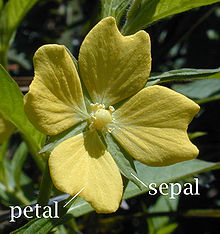Petal

Petals are modified leaves that surround the reproductive parts of flowers. They often are brightly colored or unusually shaped to attract pollinators. Together, all of the petals of a flower are called a corolla. Petals are usually accompanied by another set of special leaves called sepals lying just beneath the corolla. When the petals and sepals of a flower look similar they are called tepals.

Variations

Petals can differ dramatically in different species. The number of petals in a flower may hold clues to a plant's classification. For example, flowers on eudicots (the largest group of dicots) most frequently have four or five petals while flowers on monocots have three or six petals, although there are many exceptions to this rule.[1]
The petal whorl or corolla may be either radially or bilaterally symmetrical (see Symmetry in biology and Floral symmetry). If all of the petals are essentially identical in size and shape, the flower is said to be regular or actinomorphic (meaning "ray-formed"). Many flowers are symmetrical in only one plane (i.e., symmetry is bilateral) and are termed irregular or zygomorphic (meaning "yoke-" or "pair-formed"). In irregular flowers, other floral parts may be modified from the regular form, but the petals show the greatest deviation from radial symmetry. Examples of zygomorphic flowers may be seen in orchids and members of the pea family.
In many plants of the aster family such as the sunflower, Helianthus annuus, the circumference of the flower head is composed of ray florets. Each ray floret is anatomically an individual flower with a single large petal.
Although petals are usually the most conspicuous parts of a flower, some species, such as grasses, have either very small petals or lack them entirely.
Similar structures
Sometimes botanically different parts have the appearance of petals. In the genus Canna the true petals are tiny while the stamens are large and brightly colored. A number of plants have bracts that resemble petals, for example in Bougainvillea, Cornus florida (flowering dogwood) and members of the Euphorbiaceae family.
Corolla

Corolla is the collective term for petals of a flower taken as a group within the calyx. Alternatively, the corolla may be considered as the inner whorl of the perianth, a collective term for the calyx and corolla. The role of the corolla in plant evolution has been studied extensively since Darwin postulated a theory of the origin of elongated corollae.[2]
The corolla extends from the calyx outwards. Within it are housed anatomy such as the corolla tube, anthers, stamen, and stigma. The corolla tube is not separate from the corolla, but identifies the base section (some corollas form lobes at the top, which distinguishes the petals from the corolla tube).[3]
Genetics
The genetics behind the formation of petals, in accordance with the ABC model of flower development, are that sepals, petals, stamens, and carpels are modified versions of each other. It appears that the mechanisms to form petals evolved very few times (perhaps only once), rather than evolving independently from stamens in a large number of plants.[4]
References
- ^ Soltis, Pamela S.; Douglas E. Soltis (2004). "The origin and diversification of angiosperms". American Journal of Botany. 91: 1614–1626. doi:10.3732/ajb.91.10.1614.
{{cite journal}}: CS1 maint: multiple names: authors list (link) - ^ Analysis of theory of evolution of corolla elongation involving pollinating species
- ^ Dr. Gurcharan Singh (2004). Plant systematics: an integrated approach. Science Publishers. pp. 76–. ISBN 9781578083510. Retrieved 20 August 2010.
- ^ Rasmussen, D. A.; Kramer, E. M.; Zimmer, E. A. (2008). "One size fits all? Molecular evidence for a commonly inherited petal identity program in Ranunculales". American Journal of Botany. 96: 96. doi:10.3732/ajb.0800038.
